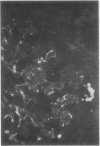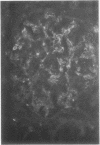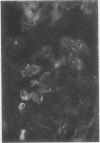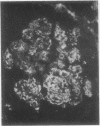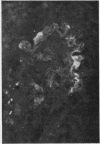Abstract
In 40 patients with a histological diagnosis of proliferative glomerulonephritis the deposition of immunoglobulins, complement (C3), and fibrin/fibrinogen has been assessed by immunofluorescence and electron microscopy. The results of such examinations have been correlated with the outcome of the illness.
In minor or resolving disease there is usually minor functional impairment, a good response to therapy or spontaneous resolution, the deposition of small amounts of material in glomerular capillary walls, and active mesangial removal. In moderate to marked disease there is initially a moderately severe functional disorder, a good response to therapy, considerable deposition of material in glomerular capillary walls but with less active mesangial regions than in the previous group. In progressive glomerulonephritis there was initial severe functional disorder, poor response to therapy, large amounts of material deposited within capillary walls, and active mesangial regions which were greatly enlarged, containing numerous deposits. In the rapidly progressive group there was severe functional disorder with poor response to therapy, the deposition of only small amounts of material within capillary walls, the lack of any significant mesangial cell reaction, and the formation of epithelial crescents.
The results of the study indicate that in proliferative glomerulonephritis following the deposition of material in glomerular capillary loops, the progression of the disease is, to some extent at least, dependent upon the ability of the mesangial cell to remove such material.
Full text
PDF










Images in this article
Selected References
These references are in PubMed. This may not be the complete list of references from this article.
- Cochrane C. G., Hawkins D. Studies on circulating immune complexes. 3. Factors governing the ability of circulating complexes to localize in blood vessels. J Exp Med. 1968 Jan 1;127(1):137–154. doi: 10.1084/jem.127.1.137. [DOI] [PMC free article] [PubMed] [Google Scholar]
- DIXON F. J., FELDMAN J. D., VAZQUEZ J. J. Experimental glomerulonephritis. The pathogenesis of a laboratory model resembling the spectrum of human glomerulonephritis. J Exp Med. 1961 May 1;113:899–920. doi: 10.1084/jem.113.5.899. [DOI] [PMC free article] [PubMed] [Google Scholar]
- Davison A. M., Thomson D., Macdonald M. K., Rae J. K., Uttley W. S., Clarkson A. R. Identification of intrarenal fibrin deposition. J Clin Pathol. 1973 Feb;26(2):102–112. doi: 10.1136/jcp.26.2.102. [DOI] [PMC free article] [PubMed] [Google Scholar]
- Galbraith S. L. The mesangium of the renal glomerulus. Scott Med J. 1971 Oct;16(10):428–437. doi: 10.1177/003693307101601002. [DOI] [PubMed] [Google Scholar]
- Germuth F. G., Jr, Valdes A. J., Senterfit L. B., Pollack A. D. A unique influence of cortisone on the transit of specific macromolecules across vascular walls in immune complex disease. Johns Hopkins Med J. 1968 Mar;122(3):137–153. [PubMed] [Google Scholar]
- LATTA H., MAUNSBACH A. B. Relations of the centrolobular region of the glomerulus to the juxtaglomerular apparatus. J Ultrastruct Res. 1962 Jun;6:562–578. doi: 10.1016/s0022-5320(62)80010-0. [DOI] [PubMed] [Google Scholar]
- MELLORS R. C., BRZOSKO W. J. Studies in molecular pathology. I. Localization and pathogenic role of heterologous immune complexes. J Exp Med. 1962 May 1;115:891–902. doi: 10.1084/jem.115.5.891. [DOI] [PMC free article] [PubMed] [Google Scholar]
- Michael A. F., Fish A. J., Good R. A. Glomerular localization and transport of aggregated proteins in mice. Lab Invest. 1967 Jul;17(1):14–29. [PubMed] [Google Scholar]
- Pincus T., Haberkern R., Christian C. L. Experimental chronic glomerulitis. J Exp Med. 1968 Apr 1;127(4):819–832. doi: 10.1084/jem.127.4.819. [DOI] [PMC free article] [PubMed] [Google Scholar]
- Shigematsu H., Kobayashi Y. The development and fate of the immune deposits in the glomerulus during the secondary phase of rat Masugi nephritis. Virchows Arch B Cell Pathol. 1971;8(2):83–95. doi: 10.1007/BF02893517. [DOI] [PubMed] [Google Scholar]



